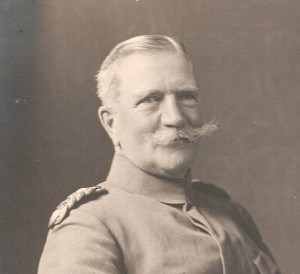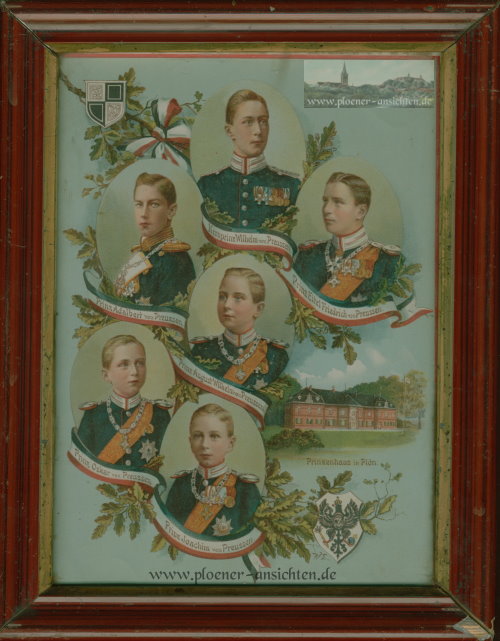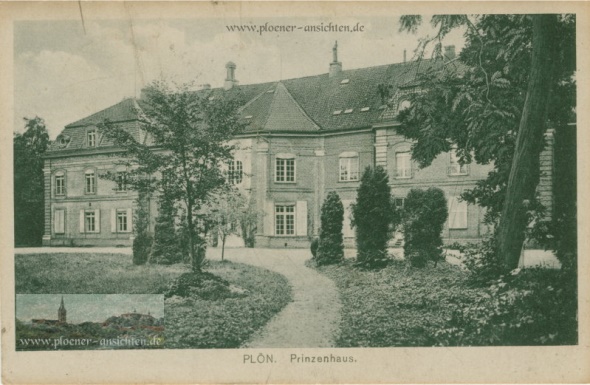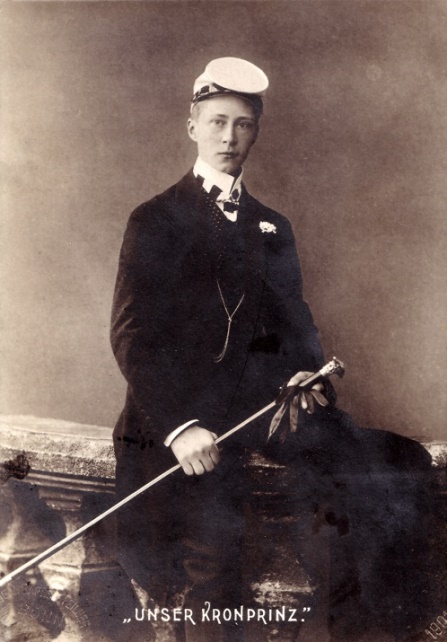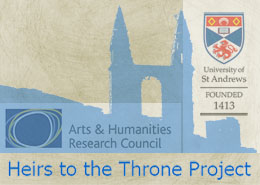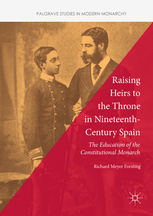“Distant from the court and all of its influences”:
The German Crown Prince at the Prinzenschule in Plön
Frank Lorenz Müller
In January 1904 the Prussian envoy to Saxony reported from Dresden that the Saxon Crown Prince Friedrich August had abandoned his plan to send his sons to the Prinzenschule (Princes’ School) in Plön in faraway Holstein. He simply could not bear to be separated from them. Instead the crown prince would now try to adapt the Plön scheme for use in the Saxon capital by having his sons Friedrich August and Friedrich Christian educated alongside boys of the same age from “good Saxon families”. When Kaiser Wilhelm learned about the original intention he was delighted and heartily agreed that it was important for young princes to be removed from the “limited atmosphere of the court for a while and gain a practical and wider view of the world through the exposure to new things”. Unsurprisingly, the crown prince’s change of heart annoyed Wilhelm II. “The point of Plön is precisely that it is not located here, but distant from Berlin!” he wrote on the margin of the report. “It would not make sense otherwise! The same goes for educating in Dresden!”[1] The Kaiser’s disappointment at the Saxon decision not to send the next generation of the royal family to be educated at the “Princes’ School” in Plön is understandable. After all, he had personally backed this innovative venture for some time and had entrusted his own sons – above all, Crown Prince Wilhelm – to the care of the new institution.
Kaiser Wilhelm’s first son – the first of six! – was born in 1882 and named Friedrich Wilhelm Victor August Ernst. In his early years Crown Prince Wilhelm – often just referred to as “KPW” for short – underwent the standard curriculum for Hohenzollern princes. From the age of six he was instructed by the experienced teacher Heinrich Fechner, the young theologian Johannes Kessler, the French tutor Charles Giradin and later the historian and philologist Dr Paul Esternaux. The traditional military dimension of KPW’s upbringing was the responsibility of his first “Military Governor”, Captain Eugen von Falkenhayn, a cavalry officer who managed to instil a lifelong love of horse riding in his young ward. Having officially joined the Prussian army aged six and been promoted to corporal a year later, KPW received a commission as lieutenant in the 1st Guards Regiment on his tenth birthday in 1892. When reflecting on his early years after the First World War, the former Crown Prince remembered that this practice of education by “third parties”, such as tutors and governors, contributed to the sense of distance and stern formality that coloured his relationship with his father. He could hardly recall an image, KPW remarked, “in which I see him in playful, unforced jollity with us”. With the benefit of hindsight, the prince came to express doubts about a form of “princely education, where strict courtly etiquette and the parents’ fearful care combined to form binding instructions for tutors, teachers and advisers.” The product of such a system would be “quite serviceable for ceremonial tasks”, he mused, but unlikely to grow into a “modern human being, who was unflinchingly part of the world around him.”[2]
Such a damning verdict must have come as a disappointment for the Kaiser, whose next steps in devising his sons’ education were meant to counteract some of the very structural disadvantages mentioned in KPW’s memoirs. In 1894 Wilhelm II decided to appoint a new Senior Governor for his sons and replaced Falkenhayn with Colonel Johann Georg Adolf von Deines, one of his Aides-de-Camp, a member of the General Staff and one of a relatively small number of university-educated officers. Rather than being a biddable courtier, the 50 year-old Deines turned out to hold some pretty firm ideas about the task ahead. A crown prince is not a higher form of human being, but simply one placed in a higher position, he wrote in a memorandum on princely education: “in order to form a capable [tüchtigen], whole man, one will have to take the same road as that for other sons of the educated classes.” Deines then listed a dozen virtuous characteristics – ranging from piety, truthfulness and optimism to a sense of duty, a good memory and a love of the people – which were hallmarks of a good man. He ended by warning against “false pride” and “modern affectation”.[3]
The Senior Governor was convinced that to achieve such lofty aims the princes had to be educated away from the distractions and damaging effects of life at the courts of Berlin and Potsdam. Deines may well have been persuaded of the necessity of such a step after his father sent him the recently published memoirs of Field-Marshall Albrecht von Roon, the legendary Prussian Minister of War. In 1848 Prince Wilhelm of Prussia (the later Kaiser Wilhelm I) had invited Roon to take charge of the education of his son, Prince Friedrich Wilhelm (the later Kaiser Friedrich III). Roon, however, insisted that it was important to continue “the prince’s education distant from the court and all of its influences”. When Prince Wilhelm and his wife Augusta refused to make this concession, the officer respectfully declined the commission. 50 years later Deines succeeded where Roon had failed – against the passionate opposition of the Empress Auguste Victoria. Crucially, he managed to win the Kaiser’s backing for his plan to continue the education of Crown Prince Wilhelm and his brother Eitel Friedrich in the picturesque and somewhat tucked-away town of Plön in Holstein, about 300 kilometres north-west of Berlin.
Plön seemed a good choice for a number of reasons: Empress Auguste Victoria was born a princess of Holstein and having her sons educated in her ancestral lands sweetened the bitter pill of having to part with them. Moreover, it made political sense to show some dynastic commitment to this recently-annexed province, which had formed part of the kingdom of Denmark until the mid-1860s. Finally, the cadet training school founded there in 1868 was highly-regarded. Soon work started to convert a small mansion in the grounds of Plön palace into living and teaching quarters for the princes. It had been decided that Wilhelm and Eitel Friedrich would not be taught alone, but would each have three class mates selected from amongst the local cadets. For KPW Senior Governor Deines chose Hans Ferdinand Count von Hochberg, Konstantin von Sommerfeld and Gustav Steinbömer. The new school was to be under the jurisdiction of the Prussian Ministry for Culture and Education and would follow the curricular regulations of a “Realgymnasium” (i.e. a secondary school emphasising modern languages and sciences, rather than classics). The central members of the teaching staff – experienced pedagogues like Esternaux or Dr Karl Sachse – were civilians. The Kaiser himself made sure that the more “modern” aspects of the curriculum received particular attention, ordering for a chemistry laboratory to be installed in the basement and increasing the number of weekly lessons in modern languages.
Soon after the royal pupils, accompanied by their mother, had arrived in Plön in April 1896, the so-called Prinzenhaus turned into a small but tightly-knit community. Senior Governor von Deines and teacher Sachse lived on site with the princes, other members of staff took up residence nearby in the town. In 1898, the Kaiser’s third son, Prince Adalbert, arrived in Plön, with sons four, five and six – August Wilhelm, Oskar and Joachim – and their respective class mates joining the school in 1901 and 1904. Beyond the core curriculum, the establishment at Plön offered a rich provision of educational opportunities which were in line – partly at least – with the contemporary concept of Progressive Education (Reformpädagogik). Ernst von Dryander, who instructed the princes in religious studies, recalled an educational idyll: “Everything was there to give cheer to the heart of a fresh, healthy boy. There was skilful gymnastics, rowing (first in large navy skiffs, later in smaller racing boats), swimming, drill, horse-riding – all amidst youthful cheer; occasionally fruit was harvested or potatoes dug.” The boys had a garden and a little farmhouse, and KPW also completed a mini-apprenticeship with a local wood-turner. But it was not all fun and games. As Dryander concluded, the expectations were high: “A Prussian prince should and must learn more than others. Not only that ours had to pass a regular final exam in a Realschule of the first order; they had to speak English and French fluently, control their horse like a cavalry soldier and ride through the countryside map in hand.”[4]
For the crown prince and his brother, the arrival at Plön thus delivered a harsh reality check: their educational attainment was below the level expected of boys of their age and sharing a classroom with peers showed this up only too clearly. For months, the princes had to get remedial extra classes to enable them to catch up, but they never managed to rise above average levels of performance. This was partly due to the fact that, for all the emphasis on bringing the princes up away from the court, aspects of court life still affected their education: they still had to perform ceremonial duties; travel to Berlin, Potsdam, the naval port of Kiel or the imperial residence at Kassel interrupted their studies; and there were regular visits from exalted personages. The Kaiser did not stop at the school very often and sometimes only stayed for minutes – literally greeting his sons and their teachers on the platform of Plön’s newly-constructed “Princes’ Station” – on his way to the Kiel Regatta. His few longer stopovers were memorable, though. KPW’s class-mate Steinbömer recalled a jaunty monarch joking with the boys, trying to catch them out with fairly lame trick questions but impressing them with improvised mini lectures on obscure topics such as the Hall Effect in electro-magnetism. The princes’ grandmother, Dowager-Empress Victoria (known as the Empress Friedrich) visited only once, but the boys’ mother, Empress Auguste Victoria, was a frequent guest at Plön. She attended the lessons, quietly doing her needlework at the back of the classroom, and treated the pupils to hot chocolate and cakes in the afternoons.
Notwithstanding the emphasis on the alleged “normality” of the princes’ educational experience – they were not to be addressed as “Your Royal Highness” and the standard rules of the Prussian ministry were to be applied to the school – there were further aspects to their life at Plön which limited KPW’s exposure to new things. The Kaiser, who remembered his own time at a public grammar school in Kassel with mixed feelings, was a keen supporter of the Plön scheme, but forbade a free intermingling between the boys at the Prinzenhaus and the cadets at the nearby training school or at the local grammar school. The crown prince experienced this relative isolation as painful and sought to circumvent his father’s orders by taking part in sporting events involving a wider group of peers. He also does not appear to have enjoyed the relationship with his immediate tutor, Major Moritz von Lyncker, whom he recalled as very dry and serious. Nor did the lessons prove a source of fun for the heir to the throne: undoubtedly quick on the uptake, KPW nevertheless showed no particular talent for any subject and never developed any real enthusiasm for his studies. In spite of this, the prince passed his school leaver’s exam (Abitur), which he took in February 1900, without embarrassment. A senior school official from the Prussian ministry, Geheimer Ober-Regierungsrat Dr Reinold Köpke, who had vetted the teaching at the “Princes’ School” on previous occasions, travelled to Plön to conduct the examination of the crown prince and his class mates. Like his father before him KPW achieved only average grades, but Kaiser Wilhelm was delighted with this outcome and awarded the helpful Köpke the suitably decorative “Order of the Royal House (2nd Class)”. KPW’s main teachers, Esternaux, Sachse and Girardin, each received a gift of 1,000 Marks.[5] Above all, the Kaiser was grateful to Deines for “having brought my eldest to this point” and for “all the sacrifices which you have made for him. May he continue to develop so well in the future”.[6]
These high hopes were to be dashed, though, as KPW turned out to be a pretty comprehensive disappointment. There were further stages along his carefully laid-out educational journey: officer training, a few semesters at the University of Bonn and internships with government departments. But when it came to turning this increasingly pleasure-seeking, easily distracted and dissipate young man into the ideal of manly seriousness Deines had aimed for, these efforts proved as ineffectual as the years KPW spent at Plön. In an angry, war-inspired diatribe, Paul Louis Hervier delivered an utter condemnation of the Hohenzollern prince: “His aspirations led him neither towards goodness, nor towards simplicity, nor towards charity, nor towards humanity, but towards robbery, treason, enjoyment and luxury”, he declared and went on to wonder whether this was “only the fruit of a too specialised education.”[7] Given the care that had gone into devising a suitable education for the heir to the German throne, this attempt at explaining why KPW had grown into such a widely despised man does not appear particularly convincing.
After all, the Prusso-German court, and especially the Kaiser, appears to have done no more than grapple with a problem that occupied all of Europe’s royal houses at the end of the nineteenth century: how best to educate the future monarch? In Britain, both Edward VII’s sons of Edward VII (Prince Albert Victor [born 1864] and the later King George V [1865]) and his grandsons (the later kings Edward VIII [1894] and George VI [1895]) were sent to naval training schools at Osborne and Dartmouth. When he was still the Prince of Naples, King Vittorio Emanuele III (1869) of Italy was taught alone but officially registered at and in line with the military schools in Naples and Modena. King Alfonso XIII of Spain (1885) was educated at the court by private tutors largely drawn from the military and later mingled with some peers for military exercises.
Against this background the education KPW and his brothers experienced at the Prinzenschule set up at Plön by his father was neither excessively focused on military matters nor lacking in progressive elements. To be sure, the progressive elements of mingling with peers and of living up to rigorous official standards appear to have been carefully circumscribed to spare the blushes of Hohenzollern offspring; and the atmosphere was definitely more courtly than austere men such as Roon or Deines would have wished, but neither the intentions behind the Plön plan nor its implementation seem to justify the negative retrospective verdicts by Hervier or the crown prince himself. Plön was certainly not the propagator for progressive constitutionalism that the radical Colonel Ludwig von Massenbach was aiming for in 1817 when he developed his plan for an “Educational Palace” for princes to be set up “far from the noise and distraction of the court, inaccessible to unctuous and fawning courtiers”.[8] But the Prinzenschule does not appear to have been a worse, more militaristic, less progressive or more brutalising attempt at educating royal princes than the efforts in other countries. By 1910, even the Kaiser’s near-inexhaustible supply of sons had dried up and when his youngest, Prince Joachim, passed his Abitur exam, Plön’s Prinzenschule was wound up.
Further Reading:
Im Dienste Preußens. Wer erzog Prinzen zu Königen. Ed. by Stiftung Stadtmuseum Berlin (Berlin, 2001)
Erinnerungen des Kronprinzen Wilhelm. Aus den Aufzeichnungen, Dokumenten, Tagebüchern und Gesprächen, ed. by Karl Rosner (Stuttgart, 1922)
Hillard, Gustav, Herren und Narren der Welt (Hamburg, 1985)
Hundert Jahre Erziehung der Jugend auf Schloß Plön 1868-1968. Eine Festschrift (Plön, 1968)
Jonas, K. W., Der Kronprinz Wilhelm (Frankfurt/Main, 1962)
Witzleben, E. v., Adolf von Deines. Lebensbild 1845-1911 (Berlin, 1913)
The images of the Prinzenhaus and of the Hohenzollern princes at Plön in the article above have been sourced from www.ploener-ansichten.de. I am grateful to Mr Ingo Buth, who is in charge of this website, for his kind permission to use these images here.
[1] Wedel (Vienna) to Foreign Office, 30-11-1903, Nr 377 (Politisches Archiv des Auswärtigen Amtes, R3265); Dönhoff (Dresden) to Foreign Office, 17-1-1904, Nr 14 (R3265).
[2] Erinnerungen des Kronprinzen Wilhelm. Aus den Aufzeichnungen, Dokumenten, Tagebüchern und Gesprächen, ed. by Karl Rosner (Stuttgart, 1922), 24-25.
[3] E. v. Witzleben, Adolf von Deines. Lebensbild 1845-1911 (Berlin, 1913), 217-219.
[4] Im Dienste Preußens. Wer erzog Prinzen zu Königen. Ed. by Stiftung Stadtmuseum Berlin (Berlin, 2001), 224.
[5] Preußisches Geheimes Staatsarchiv (Berlin), I. HA, Rep. 89, Nr 3101 (Deines to Lucanus, 1-3-1900).
[6] Witzleben, Deines, 244; I. HA, Rep 89, Nr 3274, ff.55-56.
[7] Paul Louis Hervier, The Two Williams. Studies of the Kaiser and the Crown Prince (London, 1916), 206.
[8] Ludwig von Massenbach, Über Fürstenerziehung in repräsentativen Verfassungen (Heidelberg, 1817), 8. – http://reader.digitale-sammlungen.de/de/fs1/object/display/bsb10763505_00005.html

